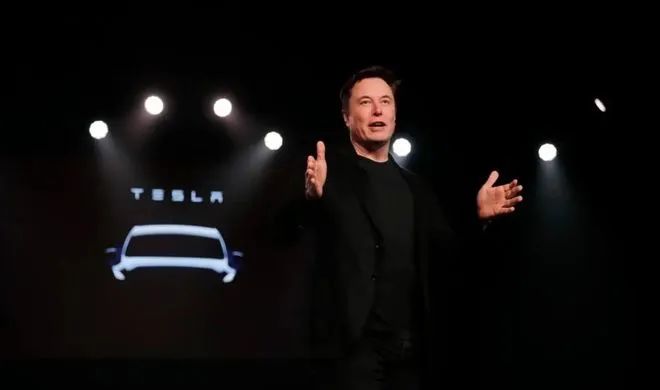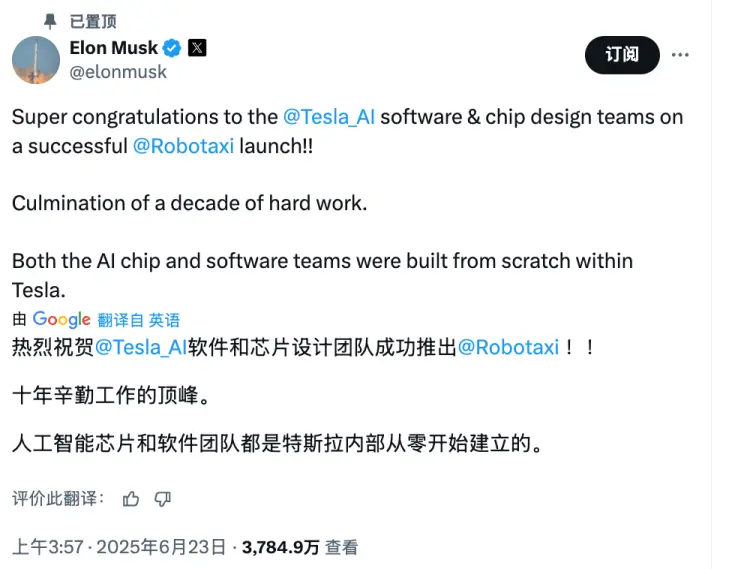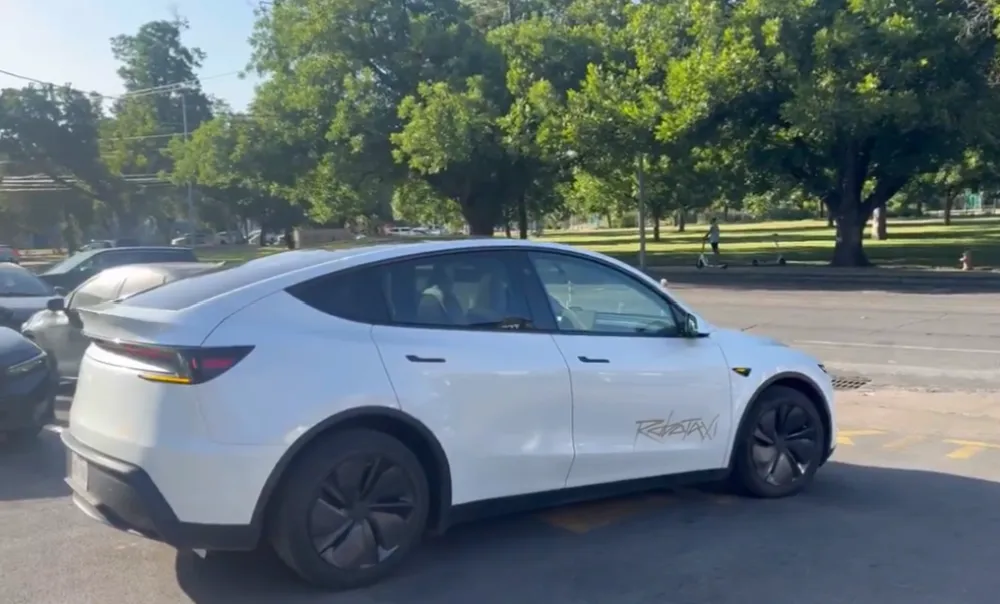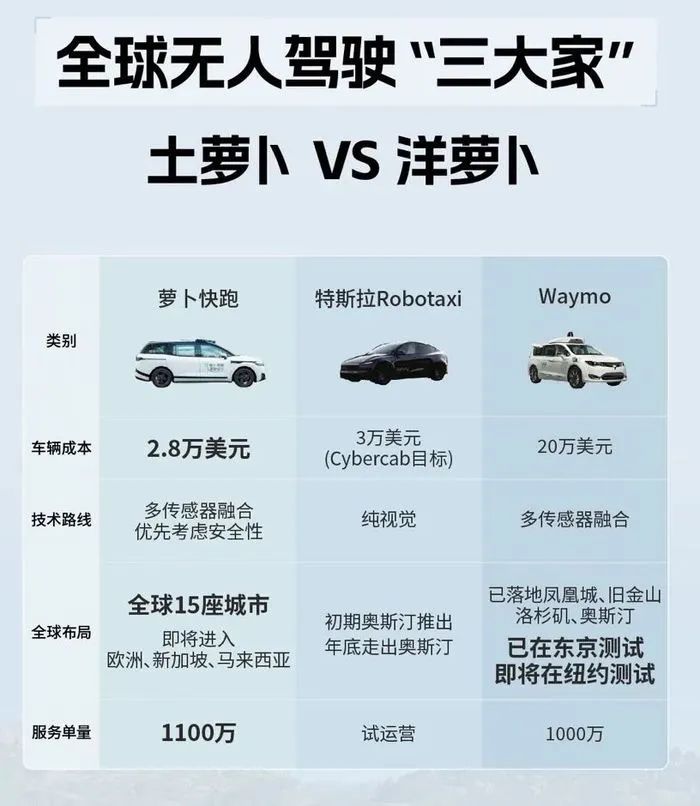Tesla's Robotaxi Hits the Road: Musk Keeps a Decade-Old Promise
![]() 06/26 2025
06/26 2025
![]() 634
634

Musk has finally fulfilled a promise made a decade ago.
On June 22, Tesla quietly launched a Robotaxi (autonomous taxi) pilot service in Austin, Texas.
Tesla's Experimental Robotaxi
This low-key launch included several key details:
Firstly, the trial is exclusive to invited users, roughly 20 influencers or Tesla enthusiasts. Only 10 to 20 refreshed Model Y vehicles equipped with the FSD (Full Self-Driving) system are operational, not the CyberCab autonomous vehicle Tesla unveiled in October last year. Regarding the CyberCab's service date, Tesla stated that there is no progress yet and will disclose it once determined.
Secondly, the service area is limited, with a geofence set up by the platform. It is confined to a small area in southern Austin, approximately 13 kilometers by 8 kilometers, taking about 30 minutes to drive from one end to the other with a speed limit of 40 miles per hour. The fare for each trip is temporarily fixed at $4.20.
Thirdly, each operating vehicle has a safety driver in the co-pilot seat, capable of manually intervening in the vehicle in emergency situations. Additionally, the Robotaxi is equipped with a remote monitoring system, and there is a "support" button on the rear screen that allows remote personnel to intervene and control the vehicle.
The influencers and Tesla fans who participated in the trial rides were very tolerant, and media and public opinion were mostly positive. Some believe that Tesla is being overly indulged. Videos shared on social media show users experiencing speed bumps and downhills with smooth driving processes. Another user stated, "This completely revolutionizes transportation and is a historic moment."
However, outsiders can still see many issues. For example, the vehicle exhibited abnormal shaking, veered into the opposite lane, mistakenly applied the brakes in the absence of obstacles, and repeatedly exceeded the speed limit at intersections.
It should be noted that Tesla's FSD has caused controversy due to multiple accidents in 2024 and was investigated by the National Highway Traffic Safety Administration (NHTSA). In May this year, NHTSA sent another letter requesting Tesla to provide details about operating Robotaxi under adverse weather conditions.
This is an inherent drawback of Tesla's FSD technology approach, which adopts a "pure vision + end-to-end" solution, removing ultrasonic sensors and eliminating LiDAR configurations. While this significantly reduces costs, it may pose safety risks in scenarios such as fog, heavy rain, and bright light. Tesla's response to this in the Robotaxi trial was to suspend operations.
Moreover, Austin is a region with mature conditions for autonomous taxi services, with suitable roads, transportation facilities, and population density for relevant testing. Waymo, a subsidiary of Alphabet, has conducted six months of safety driver testing and six months of testing without safety drivers in Austin, deploying approximately 100 autonomous vehicles and being the only company in the area at the "deployment stage".
Clearly, Tesla's Robotaxi is not fully prepared and was hastily launched with various restrictions. This half-baked Robotaxi can hardly be seen as anything other than a delaying tactic employed by the career-frustrated Musk to alleviate the operational pressure on Tesla.
In the first quarter of 2025, Tesla's vehicle deliveries declined by 13% year-on-year, marking the worst quarterly performance since 2022, and the company's market value has continued to decline. In May this year, BYD surpassed Tesla to become the global leader in pure electric vehicle sales.
Amid pressure on its automotive business, another explosion of the Starship, and the funding of AI startup X AI, Tesla urgently needs to prove the feasibility of its AI strategy. Reports indicate that Musk has halted the highly anticipated affordable electric vehicle project, Model 2, and instead is betting the company's future on AI products such as Robotaxi and humanoid robots.
The official response confirms this. Tesla stated that the successful launch of Tesla Robotaxi not only signifies the beginning of a new commercial chapter for Tesla but also represents the full realization of Tesla's autonomous driving technology approach of "vision + end-to-end model".
Musk also congratulated the Tesla team on social media, calling it "the pinnacle of (everyone's) decade of hard work, with the AI chip and software teams both created from scratch within Tesla." He also shared multiple posts to build momentum.

Image source: Musk X screenshot
Musk's Decade-Long Promise
In fact, Musk has been promising Robotaxi for nearly a decade. As early as 2016, Musk proposed the initial concept of Robotaxi, envisioning a future where users could connect their private vehicles to a sharing network to achieve "zero idle time".
He stated that Robotaxi would revolutionize transportation, creating an "autonomous, shared, electric" future that would bring huge benefits to Tesla, calling it a "trillion-dollar opportunity": Robotaxi fleets could achieve high utilization rates (over 40 hours per vehicle per week), with gross margins potentially reaching 70-80%, far exceeding traditional automotive businesses.
Over the following years, Tesla's technology approach for autonomous taxis evolved, culminating in 2024 with the unveiling of the Cybercab concept car, finalizing its technology approach as "pure vision + end-to-end large model," which also reconstructed the underlying logic of the autonomous driving industry through a closed loop of "data-algorithm-hardware".
This has firmly tied the autonomous driving industry and Musk together in the eyes of the industry and capital markets, making Tesla an unignorable leading player in the field of autonomous driving.

Tesla Model Y providing Robotaxi services. Image source: Internet
UBS released a research report on the 23rd, stating that if autonomous taxi services proceed as planned (including technology, regulation, network construction, and scaling), it could be a huge market. By 2040, Tesla's Robotaxi network in the United States is expected to expand to 2.3 million vehicles, with annual revenue potentially reaching $203 billion, contributing up to $86 billion in after-tax operating profit to the company.
UBS emphasized that Tesla's biggest advantage lies in its vertical integration capabilities. The company not only independently develops the FSD (Full Self-Driving) system but also has vehicle manufacturing capabilities and an operating platform. This makes Tesla the only enterprise currently capable of unifying "vehicle + software + network platform" as a package.
UBS believes that this structural advantage allows Tesla to benefit simultaneously from: vehicle sales profits; subscription revenue from FSD software; and commission income from the Robotaxi platform.
Furthermore, Tesla can dynamically adjust supply through platform mechanisms, avoiding the risk of resource idleness caused by peak-to-off-peak fluctuations in a single mode.
In the industry's view, Tesla hopes to directly bridge the entire process from L2 to L4 through mass-produced technology and rely on two models, Robotaxi and FSD (software payment), to establish two new business models in addition to vehicle sales. Morgan Stanley's model shows that 60%-80% of Tesla's future valuation comes from expectations for its Robotaxi and FSD businesses.
The crux of this strategy is equivalent to Tesla creating another Tesla and attempting to obtain ultra-high valuation in the capital market by running a "hardware pre-installation + service subscription" business model. Judging from the current market performance and public opinion, capital and most Musk fans are very receptive. For example, Tesla's share price rose 9% on Monday after the launch of Tesla Robotaxi.
Tesla Faces Challenges from "Local Competitors"
However, the future of Tesla's Robotaxi still needs time to prove itself. Besides common industry issues such as safety, operational infrastructure, actual deployment, and the most challenging compliance, a realistic challenge is that the autonomous taxi sector is no longer what it was a decade ago, and Tesla's Robotaxi is facing numerous powerful competitors who have run further.
In its home market, Waymo, a subsidiary of Google, has been the leader in autonomous taxi services in North America, with over 250,000 paid autonomous rides per week and a cumulative volume of over 10 million rides, with paid services starting in 2018.
Currently, Waymo operates in cities such as Austin, Los Angeles, and San Francisco, and is about to enter New York for testing, with plans to expand into Atlanta, Miami, and Washington, among other cities. Additionally, it has started testing in Tokyo as a bridgehead for its global layout.
Zoox, a subsidiary of Amazon, will also launch Robotaxi services, and ride-hailing platforms such as Uber and Lyft have also completed their commercial layouts. The former integrates solutions from technology providers like Waymo into its autonomous ride-hailing services, while the latter cooperates with companies like Mobileye, planning to launch autonomous taxi services in Dallas in 2026.
Another hurdle Tesla's Robotaxi needs to overcome is the "Chinese Autonomous Driving Troop" led by Baidu's Luobo Kuaipao, including autonomous driving technology providers such as WeRide and Pony.ai, as well as mobile travel giants like Didi Chuxing and T3, and automotive giants like BYD and Geely (which owns Cao Cao Mobility).
Among them, Baidu's Luobo Kuaipao is at the forefront. Public information shows that Luobo Kuaipao has been launched in 15 cities worldwide, and as of May this year, its global service volume has reached 11 million rides, surpassing Waymo's 10 million rides. Meanwhile, its commercial reach extends to the Middle East (Dubai, Abu Dhabi), Southeast Asia (Singapore, Malaysia), and Europe (Switzerland, Turkey).
This means that Luobo Kuaipao's overseas expansion has been systematic and model-based, which is more lethal and penetrating than simple product exports. This also makes Baidu's Luobo Kuaipao, Waymo, and Tesla's Robotaxi known as the "Global Autonomous Driving Big Three." Baidu expects Luobo Kuaipao to become profitable in 2025.

Image source: Internet
According to analysis by Zimu Bang, the reason behind Luobo Kuaipao's faster pace is its competitive advantage in the two core elements of Robotaxi: cost and safety.
In terms of cost, the sixth-generation autonomous vehicle currently in operation by Luobo Kuaipao has a vehicle cost of $28,000, only one-seventh of Waymo's cost and lower than the expected $30,000 cost of Tesla's CyberCab, which is expected to be launched next year. The current HW4.0 version of the Model Y used by Musk in the trial operation has a starting price of over $36,000 in the Chinese market.
Luobo Kuaipao's technical safety solution is also impressive. In terms of handling complex traffic scenarios, Luobo Kuaipao is on par with Waymo. In real-world test environments with more complex road conditions and traffic than in the United States, Luobo Kuaipao has achieved a record of 170 million kilometers without any major accidents.
Last May, Baidu Apollo released Apollo ADFM (Autonomous Driving Foundation Model), the world's first large model supporting L4 autonomous driving. The sixth-generation autonomous vehicle of Luobo Kuaipao thus became the world's first autonomous driving player to apply the large autonomous driving model ADFM, forming a trinity safety solution of "Apollo ADFM large model + hardware products + security architecture".
Pony.ai also performed well. In the first quarter of 2025, its Robotaxi business revenue increased by 200% year-on-year, with the number of registered users growing by over 20% month-on-month. Through its seventh-generation autonomous driving system, Pony.ai has reduced hardware costs by 70% and achieved 100% coverage of automotive-grade components.
In terms of local resource expansion, Pony.ai has established strategic cooperation with Toyota, BAIC, and GAC and has accessed platforms such as Alipay and Gaode Maps. Recent cooperation with Tencent Cloud will further enable its services to be accessed through the "Travel Services" entry on WeChat, reaching over one billion users.
The "local vs. foreign" battle in Robotaxi has its own merits. For Tesla, Musk's decade-old promise is still half-baked, but it is still sought after by capital and fans. This also provides several insights for China's "local competitors":
Firstly, Tesla's official entry is not a bad thing. On the one hand, Musk's personal popularity and Tesla's halo effect allow the market and the general public to see the future potential of Robotaxi, accelerating cognitive education and jointly expanding this pie.
On the other hand, the actual performance of Tesla's Robotaxi also to some extent dispels the mystique surrounding "foreign competitors" for users. Besides objectively recognizing their technology approach and commercialization efficiency, it also opens a larger window for the outside world, especially the global market, to see that the power accumulated by China's "local competitors" is not inferior to that of "foreign competitors".
Secondly, there is no superiority or inferiority between the two technology approaches represented by Tesla, Waymo, and other "foreign competitors" and Baidu's Luobo Kuaipao. Their value ultimately needs to be tested by the market and users. When placing both types of competitors in the same competitive environment, the bigger variable is policy coordination.
Just like TikTok's "sell or shut down" dilemma and Apple's decision to store data for its Chinese cloud services in Guizhou, technology approaches will ultimately give way to technical standard systems. "Local competitors" such as Baidu's Luobo Kuaipao, with the Chinese market as their foundation, operate globally and compete on the same stage as "foreign competitors" without fear.
Thirdly, it is imperative to speak out boldly and courageously, firmly seizing the discourse power shaping the future of travel. While policy factors can significantly impact the progression of autonomous driving, they cannot deter the inexorable trend towards rapid advancement in this sector.
In this context, armed with core technology and maintaining steadfast patience and focus, it is more advantageous to proactively shape the tide of the times rather than merely await the winds of policy change. By swiftly acting, showcasing robust market performance and reputation, and catalyzing enhancements or deregulations in relevant policies through technical standards, Tesla has established this as its "norm".
This approach echoes the sentiment expressed when Baidu's Luobo Kuaipao faced criticism as an "idiotic radish" in Wuhan in 2024. In response to complaints, the Administrative Committee of the East Lake New Technology Development Zone remarked, "As an emerging technology, driverless technology is continuously being refined and promoted." The public, too, exhibited ample patience and confidence in the capabilities of local autonomous vehicles.
References:
Tang Chen, "Baidu Luobo Kuaipao: Not Running Fast Enough in Wuhan?"
Lanjing News, "Tesla's Robotaxi Hits the Road for Just 30 Yuan per Ride"
Wall Street CN, "Musk's Next Trillion-Dollar Race? UBS Unpacks the Robotaxi Business Model"
TMTPost, "Tesla Unveils Robotaxi: The Opening Salvo in a Decade-Long Bet on AI Commercialization"







